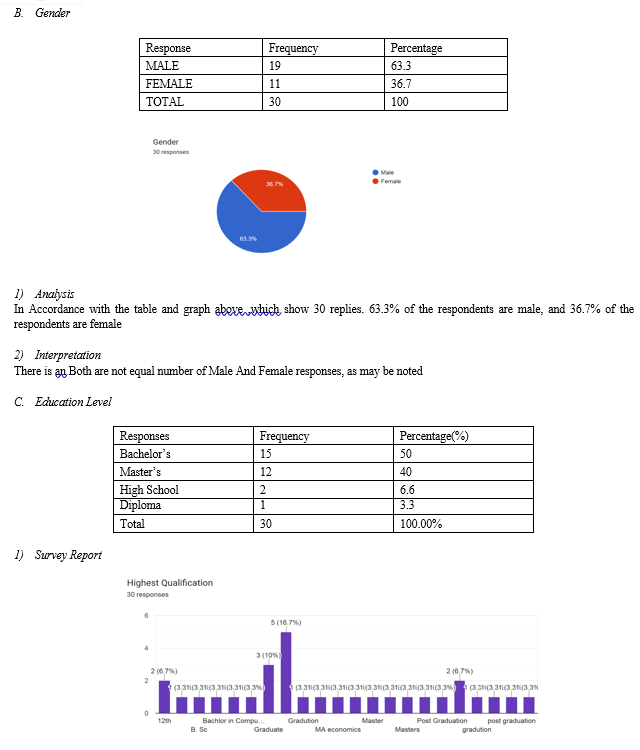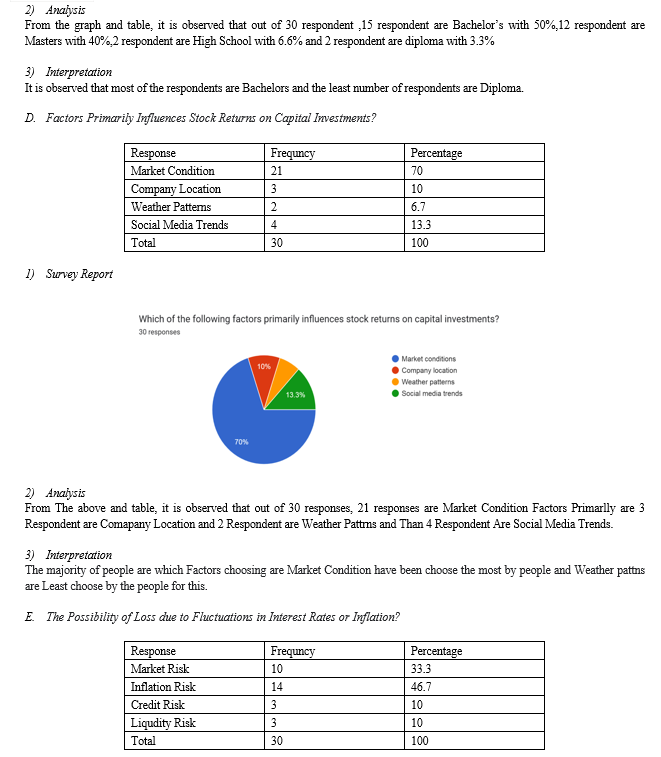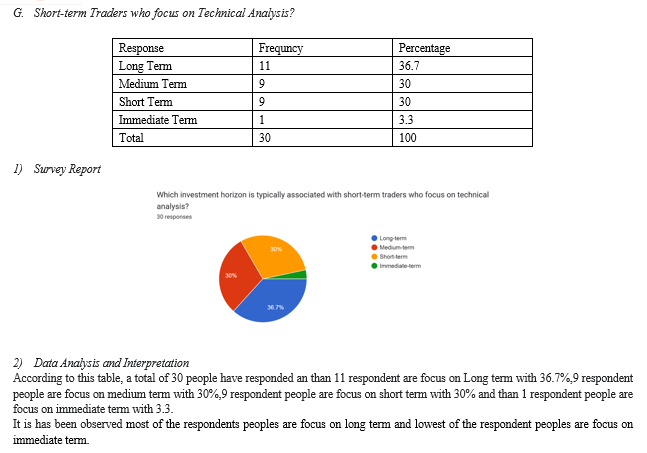Ijraset Journal For Research in Applied Science and Engineering Technology
- Home / Ijraset
- On This Page
- Abstract
- Introduction
- Conclusion
- References
- Copyright
Stock Returns on Capital Investments
Authors: Preeti Kuldeep, Dr. Bajrang Yadav
DOI Link: https://doi.org/10.22214/ijraset.2024.62284
Certificate: View Certificate
Abstract
A crucial component of financial research and investment decision-making is the link between capital investments and stock returns. Stock returns show how a company\'s stock performed over a given time period, whereas capital investments show how money was allocated to assets that were meant to yield returns in the future. Examining a range of variables, including market conditions, industry dynamics, macroeconomic considerations, the effectiveness of capital allocation, and the calibre of investment decisions, is necessary to comprehend how capital investments affect stock returns. This field of study frequently uses empirical research to investigate the relationship between capital investments and stock returns by looking for trends and correlations in historical data. Important indicators including profitability ratios, EPS growth, and return on invested capital (ROIC) are frequently used to evaluate the efficiency with which capital expenditures produce value for shareholders. Studies may also look into how the market responds to company announcements of capital investment plans, evaluating the impact on stock values and investor mood.
Introduction
I. INTRODUCTION
The Indian stock market, sometimes referred to as the Indian equity market, is a thriving and varied marketplace where people and organisations can purchase and sell shares in publicly traded corporations. This is a quick overview of the Indian stock market.
What is the stock market in India? The trading platform for a variety of financial assets, including stocks, bonds, derivatives, and mutual funds, is the Indian stock market. The Securities and Exchange Board of India (SEBI), which oversees it, guarantees honest trading and investor protection1.
The buying and selling of shares of publicly traded corporations takes place on the stock market, a dynamic and intricate network. Now let's examine the main facets of the stock market:
- Meaning and Objective: The stock market, sometimes referred to as the equity market or share market, is the gathering place for buyers and sellers of stocks (usually referred to as referred to as shares). Stocks are claims to ownership in companies. Securities traded privately (such as shares of private enterprises sold to investors through equity crowdfunding platforms) or listed on public stock exchanges may be included in these claims.
- Function and Significance: By permitting the transfer of funds between investors and businesses, the stock market is essential to contemporary economies. It acts as a forum for businesses to raise money for debt repayment, business expansion, or new enterprises’ Businesses that are publicly listed, or whose shares are exchanged on stock exchanges, are susceptible to regulations pertaining to transparency and reporting. A variety of factors lead investors to engage in the stock market, such as the desire for dividend income, capital growth, and ownership influence over companies. through the ability to cast a vote at shareholder meetings.
- Stock Exchanges: As a component of the broader stock market, stock exchanges allow traders to purchase and sell shares. The New York Stock Exchange (NYSE) and Nasdaq are two significant U.S. stock exchanges. These exchanges offer a venue for liquid trading, price discovery, and efficient trade. A broad spectrum of investors, including both ordinary retail investors and institutional players, can purchase stocks listed on exchanges.
- Price Determination: A number of factors, including supply and demand, firm performance, the state of the economy, and investor attitude, influence stock prices
II. REVIEW OF LITERATURE
- Cooke (1992) T. E. The dedication to thoroughly evaluating Japanese financial data is discussed in the report, along with the specific impact that size, stock market posting, and industry type have on disclosures. Posting status and found size are important logical elements. Similarly, manufacturing companies were found to disclose far more information than other Japanese partnership types. Critical communication was also shown to exist between industry type and citation status.
- Worrell, D. I.; Glascock, J. L.; and Davidson, W. N. (1993). Reviewers look at investors' answers to statements. Although different types of terminating declarations did not cause a marked reaction, we observed that declarations providing data about long-lasting supplanting were associated with favourable market responses. Furthermore, pariah alterations were immediately regarded as useful.
- Cormier, D., Mag?nan, M., and Morard, B. (1993). It is assumed that businesses having. A strong environmental track record should be valued by the stock market at a premium. This relationship arises from the growth of "moral" money management and investors' growing understanding of the unfavourable outcomes that are anticipated from corporate ecological problems.
- Jacobson, R., and Aaker, D. (1993) To acquire bits of knowledge about conceivable cross-public contrasts in lopsided data among directors and investors. Our discoveries demonstrating that the Japanese stock market integrates data sooner than the U.S. stock market are predictable with the speculation that Japanese investors, who will quite often have close connections to the organizations they put resources into, prefer to be informed over
- Zahra, S. A. (1996). Corporate business is significant for authoritative endiarance, productivity, development, and restoration Pariahs, including stock proprietors, could lead organizations from inner item improvement, the customary course, to corporate business ventures. Finally, an industry's mechanical open doors moderate the affiliations between corporate administration and proprietorship factors and corporate business ventures
- Ujit and Amrit (1996) stated that tax benefits were the main factor influencing groups of salaried and business class people to invest in common assets.
- Morgan, A. G., and A. D. Miyazaki (2001) The challenges of evaluating sports sponsorship is noteworthy. In this investigation. Miyazaki and Morgan assessed corporate sponsorship of the 1996 Olympic Games using "event study analysis." The theory, well-known in the financial community, holds that a movement's outcomes are mirrored in the market price of the supporting stock. There was a good movement dynamic.
- According to Elmiger and Kim (2003), hazard is the trade-off that investors must make between the increased risks that must be taken as an investment and the higher prices that often go along with the various investing gambles. 6 result of the danger
III. OBJECTIVE OF RESEARCH
- Evaluation of Investment Impact: Find out how capital asset investments influence the performance of a company's stock.
- Assessment of Growth Potential: Recognize whether capital investments support future expansion and profitability.
- Investor Decision Making: Educate investors on the ways in which capital expenditures affect stock prices and investment choices.
- Company Performance Analysis: Evaluate how well an organization invests in order to generate long-term value for shareholders.
- Value Creation Analysis: Evaluate how well capital expenditures generate long-term shareholder value.
A. Hypothesis
H0 - The majority of influencing factors do not significantly affect consumers' decisions to buy clothes via social media sites.
H1 - The majority of influencing factors have a substantial impact on consumers' decisions to buy clothing via social media channels.
H0 - Customers' experiences making purchases on social media platforms have no discernible influence on whether or not they recommend social media purchases to others.
H1: Consumers' experiences making purchases on social media platforms have a big influence on whether or not they promote social media purchases to others.
B. Scope Of The Study
Scope in the stock market" can relate to a number of different things, including employment opportunities, growth potential, and the variety of financial instruments that are available. This is a synopsis that addresses these issues:
- Employment Prospects: The stock market provides a variety of job options, such as market maker, stockbroker, sub-broker, research analyst, and hedge fund trader. Success in this area requires a strong passion for the market and a commitment to lifelong learning. Certifications such as NISM/NCFM and an MBA in Finance can be helpful...
- Market Growth: On January 22, 2024, India's stock market capitalization reached $4.33 trillion2, surpassing Hong Kong's for the first time. The two main exchanges in India are the National Stock Exchange (NSE) and the Bombay Stock Exchange (BSE). The BSE and NSE trade from 9:15 a.m. to 3:30 p.m. using an open electronic limit order book.
- Financial Instruments: Stocks, bonds, mutual funds, and derivatives are just a few of the financial instruments available in the stock market. It is an important component of the financial system and acts as a gauge of a nation's economic health
IV. RESEARCH METHOLODGY
Statistical and quantitative analysis methods are frequently used in research on the connection between capital investments and stock returns. Here is a summary of the main actions that are involved:
- Data Collection: Compile historical information for the companies or industries of interest about capital investments and stock returns. Capital investment data can include expenses on property, plant, and equipment as well as other tangible assets, whereas stock return data can include daily, weekly, or monthly price fluctuations.
- Time Period Selection: Choose how long to conduct the analysis over. In order to identify significant patterns and linkages, the time frame must be long enough, but not so long that changes in market dynamics or company circumstances render the historical data obsolete.
- Data Transformation: As needed, clean up and preprocess the data. This could entail smoothing or aggregating capital investment data to account for anomalies in reporting, as well as accounting for inflation, stock splits, and dividends.





VI. FINDINGS
- It is observed that most of the respondent are in The age Group of 18-24 Years and the least number of respondents to the age group of 41-45 Years
- It is observed that most of the respondents are Bachelors and the least number of respondents are Diploma
- The majority of people are which Factors choosing are Market Condition have been choose the most by people and Weather pattns are Least choose by the people for this
- It is has been observed most of the respondents are possibility in inflation risk and the least number of respondents are credit and liquidity risk both
- It is has been observed most of the respondents are ROI with 40% and least number of respondents are EPS with 6.7%.
Conclusion
The study of Stock Returns on Capital Investments it is observed that out of 30 Responses,16 Respondent is from 18-24 age group with 53.3%,9 respondent is from 25-34 age group with 29.8%,2 respondent is from 35-40 age group with 6.6%,1 Respondent is from 41-45 age group with 3.3%,2 Respondent is from 46-55 age group with 6.6%.and than this ages group whidecided to our Answer and People that research on this topic is a much better choice Investing in physical assets, infrastructure, and technology are examples of capital expenditures that are necessary to improve a company\'s competitive edge, productivity, and innovation. Effective capital investments typically result in increased future profitability and better stock returns. This is so that businesses can increase their market share, boost productivity, and keep up with technology developments.
References
[1] Zingales, L., and S. N. Kaplan (1997). The following uses of investment-cash flow sensitivities: A theoretical justification for investment regressions in reduced form. 52(3) Journal of Finance, 707-712 [2] Asker, J., Ljungqvist, A., and Farre-Mensa, J. (2011). Corporate Investing and Listing on the Stock Market: An Enigma? 28(2), 342–390, [3] Review of Financial Studies.Welch (2004). Synthesis of capital investment and stock returns. 10(2), 205-229 [4] European Financial Management.A. Edmans (2011). Is intangible value fully valued by the stock market? Prices for equity and employee satisfaction. 621-640 [5] Journal of Financial Economics, 101(3).J. H. Cochrane (1991). The relationship between stock returns and economic changes and asset price based on investments. 46(1) Journal of Finance, 209-237 [6] Arora, A., Gambardella, A., and Fosfuri, A. (2001). the effect of R&D expenditures on business performance under various market scenarios. 47(6) Management Science, 875-899 [7] Malitz, I. B., and Long, M. S. (1985). Financial, investment, and dividend policies of corporations. 14(1), 379–400, Journal of Financial Economics [8] In 1999, Folta, T. B., and Rajagopalan, N. Evidence from deregulated industries about how the market responds to decisions about capital investments. 51(1), 83-109 in Journal of Financial Economics [9] In 2003, Chen and Zhang published a book. The premium for expected value. 529–582, Journal of Financial Economics, 69(3)
Copyright
Copyright © 2024 Preeti Kuldeep, Dr. Bajrang Yadav. This is an open access article distributed under the Creative Commons Attribution License, which permits unrestricted use, distribution, and reproduction in any medium, provided the original work is properly cited.

Download Paper
Paper Id : IJRASET62284
Publish Date : 2024-05-17
ISSN : 2321-9653
Publisher Name : IJRASET
DOI Link : Click Here
 Submit Paper Online
Submit Paper Online

